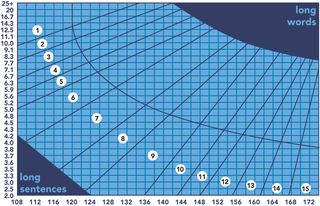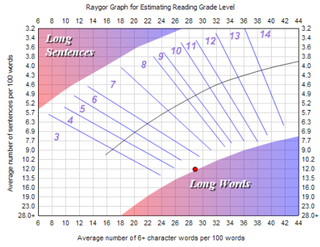Plain language is writing designed to ensure the reader understands as quickly, easily, and completely as possible. Plain language strives to be easy to read, understand, and use. It avoids verbose, convoluted language and jargon. In many countries, laws mandate that public agencies use plain language to increase access to programs and services. The United Nations Convention on the Rights of Persons with Disabilities includes plain language as one of the "modes, means and formats of communication".
Readability is the ease with which a reader can understand a written text. In natural language, the readability of text depends on its content and its presentation. Researchers have used various factors to measure readability, such as
The Flesch–Kincaid readability tests are readability tests designed to indicate how difficult a passage in English is to understand. There are two tests, the Flesch Reading Ease, and the Flesch–Kincaid Grade Level. Although they use the same core measures, they have different weighting factors.
In linguistics, the Gunning fog index is a readability test for English writing. The index estimates the years of formal education a person needs to understand the text on the first reading. For instance, a fog index of 12 requires the reading level of a United States high school senior. The test was developed in 1952 by Robert Gunning, an American businessman who had been involved in newspaper and textbook publishing.
Readability tests, readability formulas, or readability metrics are formulae for evaluating the readability of text, usually by counting syllables, words, and sentences. Readability tests are often used as an alternative to conducting an actual statistical survey of human readers of the subject text. Word processing applications often have readability tests built-in, which can be deployed on documents in-editing.

The Fry readability formula is a readability metric for English texts, developed by Edward Fry.
The automated readability index (ARI) is a readability test for English texts, designed to gauge the understandability of a text. Like the Flesch–Kincaid grade level, Gunning fog index, SMOG index, Fry readability formula, and Coleman–Liau index, it produces an approximate representation of the US grade level needed to comprehend the text.
The Coleman–Liau index is a readability test designed by Meri Coleman and T. L. Liau to gauge the understandability of a text. Like the Flesch–Kincaid Grade Level, Gunning fog index, SMOG index, and Automated Readability Index, its output approximates the U.S. grade level thought necessary to comprehend the text.

Cambridge English: Young Learners, also known as Young Learners English Tests (YLE), is a suite of English language examinations specially designed for children in primary and lower-secondary school. The tests are provided by Cambridge English Language Assessment.
Accelerated Reader (AR) is software for K-12 schools for monitoring the practice of reading. It was developed by Renaissance Learning, Inc. There are two versions: a desktop version and a web-based version in Renaissance Place, the company's online portal.
BLEU is an algorithm for evaluating the quality of text which has been machine-translated from one natural language to another. Quality is considered to be the correspondence between a machine's output and that of a human: "the closer a machine translation is to a professional human translation, the better it is" – this is the central idea behind BLEU. BLEU was one of the first metrics to claim a high correlation with human judgements of quality, and remains one of the most popular automated and inexpensive metrics.
The Secondary School Admission Test (SSAT) is an admission test administered by The Enrollment Management Association in the United States to students in grades 3–11 to provide a standardized measure that will help professionals in independent or private elementary, middle, and high schools to make decisions regarding student admission.

The Raygor estimate graph is a readability metric for English text. It was developed by Alton L. Raygor, who published it in 1977.
The SMOG grade is a measure of readability that estimates the years of education needed to understand a piece of writing. SMOG is an acronym for Simple Measure of Gobbledygook.

Dyslexia is characterized by learning difficulties that can include:
The Spache readability formula is a readability test for writing in English, designed by George Spache. It works best on texts that are for children up to fourth grade. For older children, the Dale–Chall readability formula is more appropriate.
Grading system in Morocco is mostly a 20-point grading scale, it is used in secondary schools as well as in universities.
The Lexile Framework for Reading is an educational tool that uses a measure called a Lexile to match readers with books, articles and other leveled reading resources. Readers and books are assigned a score on the Lexile scale, in which lower scores reflect easier readability for books and lower reading ability for readers.
Using controlled language in machine translation poses several problems.
The Dale–Chall readability formula is a readability test that provides a numeric gauge of the comprehension difficulty that readers come upon when reading a text. It uses a list of 3000 words that groups of fourth-grade American students could reliably understand, considering any word not on that list to be difficult.





